NEWDOS 2.1
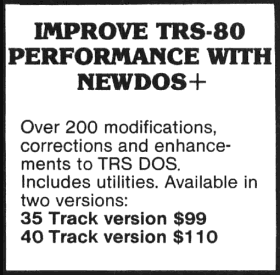
Portion of Apparat advertisement from the September 1979 issue of BYTE
Origins
In mid-1978 when Radio Shack introduced TRSDOS 2.0, their first disk operating system for the Model I, it contained many bugs. Some were fixed by TRSDOS 2.1 later that year, but many bugs remained, some quite severe.
One of the first people to attempt to fix these bugs was Clifford Ide. He analyzed Model I TRSDOS in great detail and developed a set of patches to fix the bugs, increase performance, and add new features. This set of patches, originally known as APRDOS, was not a commercial product but was only available to those who knew someone who already had a copy.
Eventually the idea came about to sell the patched operating system as a separate product through Apparat, a company owned by Jim Lauletta. At the time, Radio Shack and others commonly referred to TRSDOS as just DOS. Dick Miller, of Miller Microcomputer Services, suggested NEWDOS as a name for the new product because the Apparat operating system was literally a new DOS, or NEW DOS. (A few early Apparat advertisements even referred to it that way, with a space between the words.) One of the earliest mentions of NEWDOS was in an April 1979 Apparat advertisement, which ends with this notice:
New DOS now available. Call or write for details.
NEWDOS was described as having “over 200 modifications, corrections, and enhancements to TRSDOS” for a price of $99 for a 35 track version or $110 for a 40 track version. It also included a number of extra utilities, including an assembler (a modified version of EDTASM), disassembler, and Superzap, a very powerful file editor.
The NEWDOS documentation, although light on user instructions, did describe the changes made to TRSDOS in great, and sometimes entertaining, detail. Here is one example:
DOS SYS0,INIT initializes 4158-43FF and then, throughout subsequent system operation, never uses it, except for unexplained reference to 4359 in SYS1, a reference to 43C0-FF by SYS6 for ‘DEVICE,' and an unintentional reference to 43FFH as a result of instructions in SYS0, 46C1-CB. I have critical need for a DOS resident patch area. I will gamble that this area is truly available and use it.
Legal issues
Contrary to some accounts, Apparat never claimed that NEWDOS was completely original. The opening screen stated:
This DOS (BOOT, SYS0-SYS6, FORMAT) originally copyrighted by Randolph H. Cook, 1978. Alterations are by Apparat.
(Later updates eliminated the incorrect middle initial.)
The manual clearly stated that the code was derived from TRSDOS:
Use of the following programs will require purchase of Radio Shack’s TRSDOS disk operating system, V.2.1 or later. The EDTASM modifications in NEWDOS+ will require purchase of the Radio Shack Editor/Assembler package.
A later manual elaborated on this point:
With these changes, Apparat does not provide copies or extracts of the original documentation for BASIC, for DOS, or for the Editor-Assembler. The original releases of these programs are copyrighted by others and sold by Radio Shack. The users/buyers of this updated system are assumed to have purchased these original programs from Radio Shack, thereby obtaining the original documentation and implicitly paying the royalties due. Apparat’s refusal to supply copies or extracts of the original documentation is its sole effort to assure royalties are being paid.
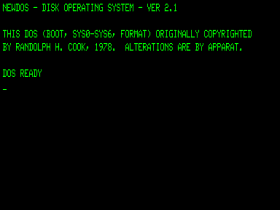
NEWDOS 2.1 title screen
Including a patched version of EDTASM made less sense, because EDTASM was a separate product with no connection to TRSDOS. There was no reason to assume that a NEWDOS purchaser already owned EDTASM. On the other hand, EDTASM would have been very difficult to use without any documentation at all.
Given that there was no dispute that NEWDOS appropriated TRSDOS code, why didn’t Radio Shack sue Apparat? It’s impossible to know for certain, but it might have been due to any number of reasons:
- Both Randy Cook and Radio Shack claimed ownership of TRSDOS 2.1, making any potential lawsuit difficult.
- Although later court cases clarified the issue, it wasn’t completely clear at the time whether software was copyrightable.
- It is likely that Radio Shack never properly copyrighted any of its early software products, including TRSDOS.
- Suing the people who were fixing the bugs in TRSDOS while Radio Shack left those same bugs unfixed would have been a public relations nightmare.
Authorship
For whatever reason, Clifford Ide’s name was never used in connection with NEWDOS. The NEWDOS author was identified only as “Sam Jones,” a pseudonym used to “keep his privacy and avoid being swamped by phone calls,” according to an 80 Micro article. In Harvard Pennington’s book TRS-80 Disk and Other Mysteries, the NEWDOS principals (Lauletta and Ide) are described not by name but as “two guys in Denver.” In the acknowledgements to the book, Jim Lauletta’s name is listed in full (although not identified with Apparat) but Clifford Ide’s name is abbreviated as C.I.
Apparat kept the true identity of “Sam Jones” a secret until a 10-year TRS-80 retrospective article called “The Tandy Story” was published in the August 1987 issue of 80 Micro. That article incorrectly (and bafflingly) identified Roy Soltoff and William Schroeder (of MISOSYS and Logical Systems) as the original authors of NEWDOS1. In an effort to correct the record, Apparat finally revealed that Clifford Ide was “Sam Jones” and the author of NEWDOS.
Clifford Ide died in 2015. As far as I know, he never commented publicly about his involvement with NEWDOS.
Legacy
In June 1980, Apparat introduced NEWDOS/80. Unlike NEWDOS 2.1, NEWDOS/80 was rewritten from the ground up and contained no TRSDOS code. NEWDOS/80 was also a far more advanced and powerful operating system and supported new hardware, such as the Percom Doubler, hard drives, and even the TRS-80 Model III. Although Apparat continued to sell NEWDOS 2.1, NEWDOS/80 was the clearly the future and NEWDOS 2.1 faded into the background.
-
Both Roy Soltoff and William Schroeder were quite upset by this mistake. In the Summer 1987 issue of The MISOSYS Quarterly, Roy Soltoff described it as “knowingly false” and said:
That’s just one more stupidly inaccurate remark made in 80 Micro which reflects on the quality of their editorial staff.
William Schroeder was even harsher, describing the article as “a distorted collage of meaningless material” and stating:
For those of you who have read the article in 80 Micro regarding the last 10 years of computing as it related to Tandy, please consider that you have read a mostly fictional account of those times. I was personally involved with Tandy as a vendor during that entire period and can tell you that that article was a “pure garbage” account of what happened.
Logical Systems stopped advertising in 80 Micro partly as a result of the article. ↩︎
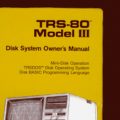
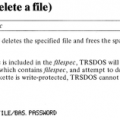
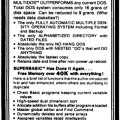
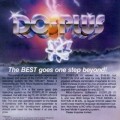










David Sutherland says:
Great research… very interesting.
The footnote to point one about dispute involving Randy Cook owning the TRSDOS copyright might point back to your good TRSDOS 2.1 article:
– http://www.trs-80.org/trsdos-model1/
but include a note about the easter egg found here:
– http://www.trs-80.com/wordpress/zaps-patches-pokes-tips/easter-eggs/
“In TRSDOS v2.1, run BOOT/SYS.WHO while holding down … the “R” and “V” keys (Randy Cook’s first two initials)” to get the following message:
Don Kleppinger says:
Interesting. Thanks for publishing this. I worked at Apparat from 1981-1986 and remember Cliff and knew Jim Lauletta. My 1st PC was a Model 1 TRS-80 that I bought when a senior in High School.